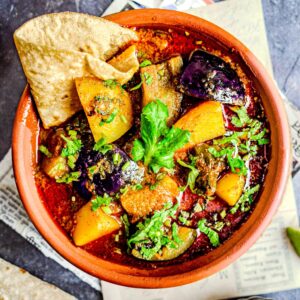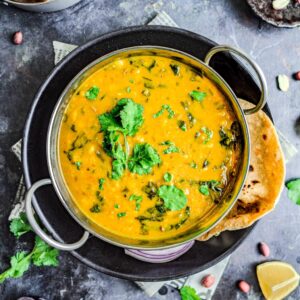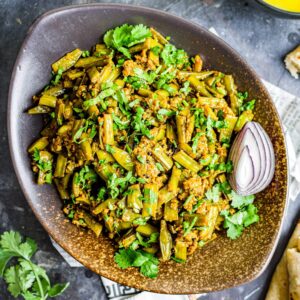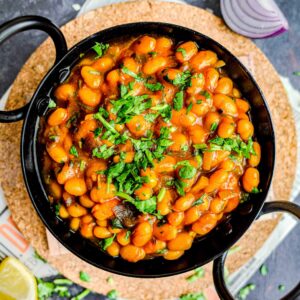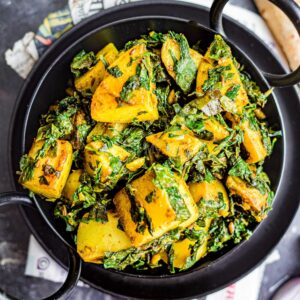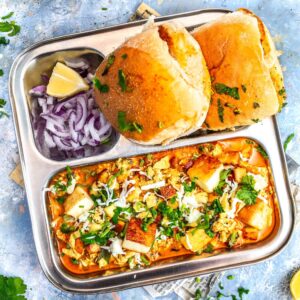Punjabi Dum Aloo, Indian Restaurant Style Curry
Potato curry with a difference — Punjabi dum aloo is made by cooking fried baby potatoes in a spicy curry finished with yoghurt and dried fenugreek. Eat with steamed rice and prepare to be wowed!
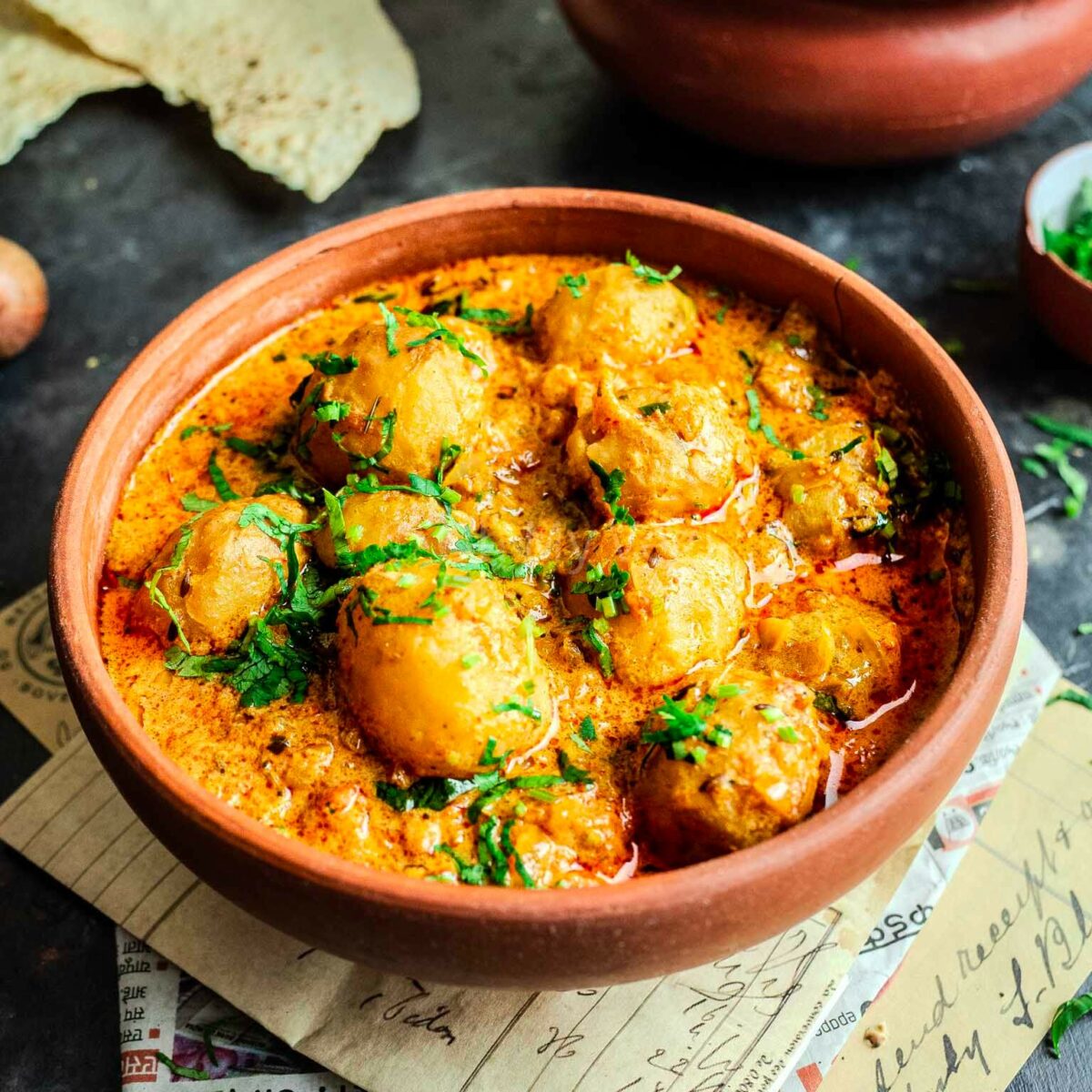
I adore Punjabi food. Here in the U.K., most Indian restaurants cook Punjabi-style dishes, so I grew up eating things like chole bhatura, palak paneer, Punjabi vegetable samosa, malai kofta, saag, and dal makhani regularly. However, when I learned to cook, I delved into Indian home cooking and discovered even more delectable dishes, like this Punjabi dum aloo recipe!
Firstly, we’ll start with crisp, golden-brown baby potatoes. I know that already sounds irresistible, but wait! The curry perfectly coats each tender, soft potato with flavour in every bite. No bland potatoes in sight!
And talking of the curry — this recipe is distinctive as we cook dum aloo with dahi (yoghurt), lending the curry gravy a unique sour tang, plus a thick, smooth, and creamy texture. That’s not to mention the aromatic spiciness from a handful of whole spices like smoky black cardamom, warm cinnamon, and pungent cloves. Are you a fan of complex flavours beyond the typical spicy heat? If yes, then there’s no question you’ll love this impressive take on potato curry.
And the best part? Punjabi restaurant-style dum aloo is 100% gluten-free, nut-free, and soy-free. It’s even easy to make the dish vegan … more on that later.
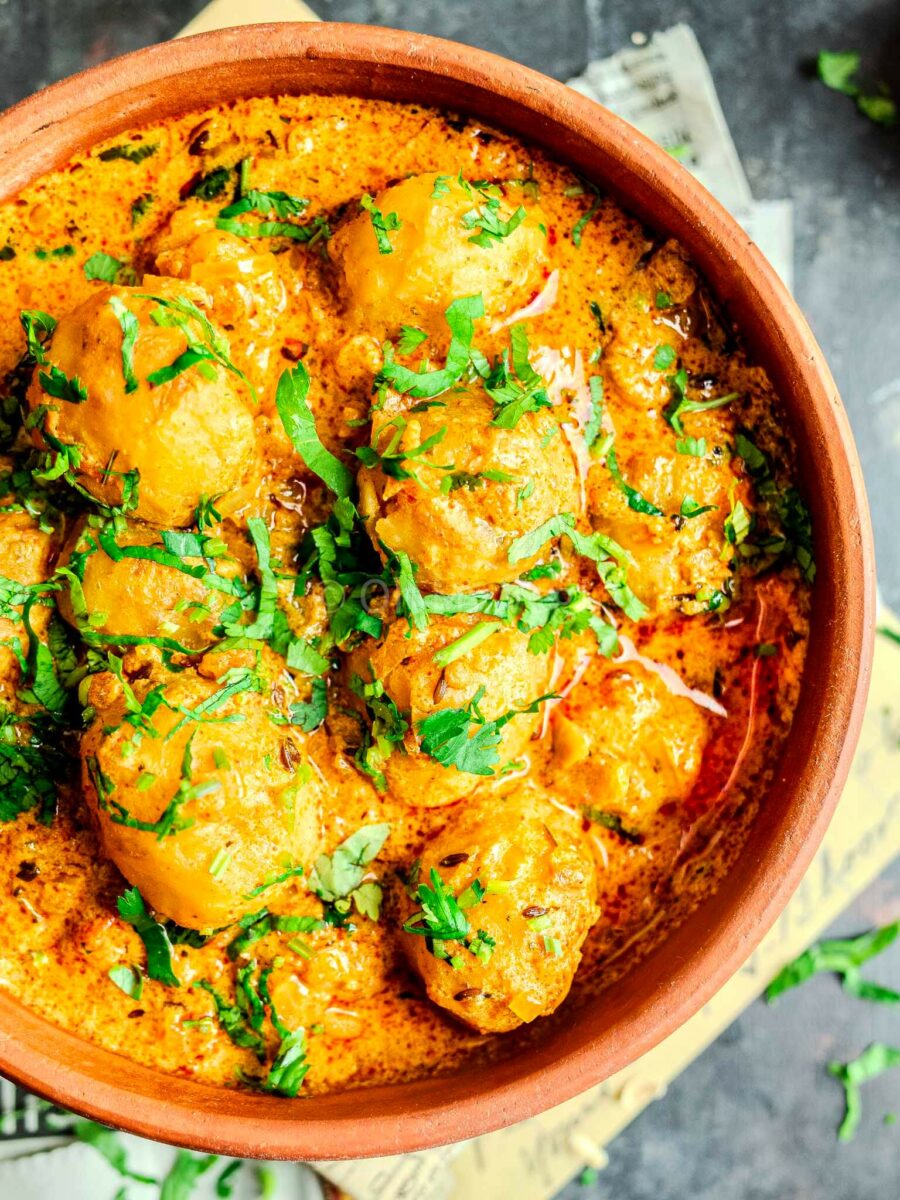
What is Dum Aloo?
Dum aloo is a type of North Indian potato curry dish. Moreover, “dum” refers to the cooking method; “on dum” means slow-cooked with steam. Other dishes like dum biryani also use this technique, and the pot is often sealed with dough so no steam can escape.
“Aloo” means potato in Hindi (a North Indian language) and refers to the main ingredient. However, instead of the large potatoes we use for Maharashtrian batata rassa or creamy malai kofta, dum aloo specifically calls for small baby potatoes. They are usually parboiled, then deep-fried, and finish cooking in the spicy gravy.
In conclusion, dum aloo is an irresistible dish with a thick, creamy, spicy, and tangy gravy. It’s a must-try for all Indian food lovers!
Types of Dum Aloo
Did you know there are four regional varieties of dum aloo? Like most Indian recipes, the dish is adapted for local tastes, resulting in numerous delicious interpretations we can try. Let’s explore some of them!
- Kashmiri dum aloo is perhaps the most famous. A fiery-red, spicy potato curry, it’s surprisingly uncomplicated. We season the dish with fruity and vibrant Kashmiri chilli powder, fennel powder, and ginger, but no onion or garlic. Additionally, yoghurt completes the sour and spicy flavour notes.
- Punjabi restaurant-style dum aloo, sometimes called Mughali dum aloo, is much creamier in taste due to the addition of cream alongside yoghurt. It’s also packed with fragrant aromatic spices like cloves, cardamon, and cinnamon. While some people don’t add tomatoes; this recipe does. It’s milder, sweeter, and creamier, although still tangy and hot.
- Banarasi dum aloo has no onion or garlic, thus, it’s a Jain recipe! It tastes like a combination of the above recipes and frequently uses herb-stuffed potatoes.
- Bengali alu’r dom is the most distinct of the above recipes. Comparatively much drier in consistency, cooked with the aroma of mustard oil, and finished with a generous pinch of garam masala, the dish is usually served with luchi or puri.
Difference Between Dum Aloo and Kashmiri Dum Aloo
Dum aloo Punjabi vs Kashmiri dum aloo are completely different interpretations of the dish.
Whereas Kashmiri dum aloo uses only powdered ingredients (except potatoes) and boasts a fruity, spicy curry gravy with a strong anise aroma from fennel, Punjabi dum aloo has a thicker gravy thanks to onions and tomatoes, a creamier texture, milder taste, and more depth from aromatic spices. Nevertheless, both recipes are fantastic!
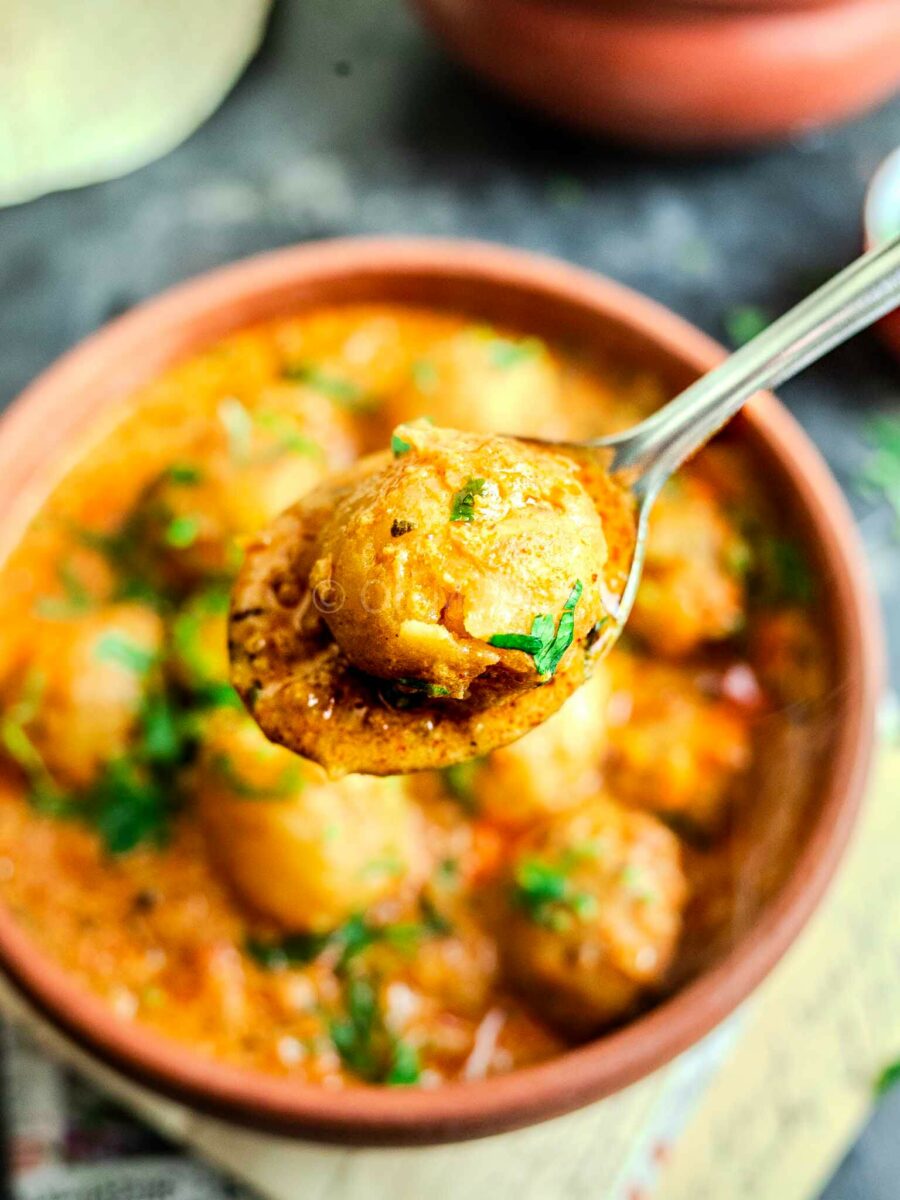
Ingredients for Dum Aloo
You might be thinking “Whew, that’s a lot of ingredients!” and you’d be right. This recipe does require a good handful of ingredients! However, most of these are pantry staples (like potatoes, onion, garlic, ginger, and tomatoes), while the others are spices. If you cook Indian food often, you’ll likely have many of these spices already stocked in your pantry. Otherwise, no problem! You can refer back to this for a shopping list.
Everything You Need 🛒
- Baby potatoes, or new potatoes, are the main ingredient of dum aloo! You can use large potatoes cut into pieces if you prefer but try to get your hands on these.
- Mustard oil provides a warm, peppery, almost spicy base.
- Cumin seeds give pops of nutty and sweet seasoning each time you bite into one.
- Green cardamom is minty, slightly spicy, warm, and citrusy all at once, adding an undeniably complex flavour to the dum aloo.
- Black cardamom is intensely smoky and woody. Don’t sub the two varieties of cardamom.
- Cinnamon stick infuses the curry gravy with an aromatic, sweet, and zesty flavour.
- Indian bay leaves provide warming and mellow notes. TIP! Don’t use European bay leaves as they have a completely different flavor.
- Cloves are pungent, spicy, and slightly bitter.
- Onions offer a caramelized sweetness. Red or white is fine.
- Ginger garlic paste adds a warm and sweet flavour with subtle punchiness. You can leave this out for a Jain-friendly recipe, but I recommend adding it.
- Tomato adds acidity and slight sweetness to the dish.
- Turmeric powder is earthy, peppery, and vibrant yellow.
- Coriander powder provides surprisingly fresh, citrusy, and almost floral notes. It’s vital for amping up the depth of flavour.
- Red chilli powder gives this Punjabi dum aloo heat.
- Kashmiri chilli powder provides a milder fruity heat and rich red colour.
- Yoghurt is a crucial component. Preferably use homemade yoghurt (or Indian curd), natural yoghurt, or Greek yoghurt for the best results.
- Kasuri methi, otherwise known as dried fenugreek leaves, finish the dum aloo with a slightly bitter, deeply savoury taste and strong aroma.
- Garam masala boosts flavour complexities with a warming hint of spice right at the end.
- Sea salt amplifies the other seasoning.
- Double cream adds richness, butteriness, and a smooth mouthfeel.
Dum Aloo Allergens
I love how most Indian recipes are allergen-friendly, especially if you cook them homemade!
This Punjabi restaurant-style dum aloo recipe is gluten-free, vegetarian (of course!), halal-friendly, nut-free, soy-free, and alcohol-free. Whew! That means it’s a great dish to serve almost anyone. Amazing for curry nights with family or friends — an authentic Indian thali.
- Is dum aloo vegan? Unfortunately not. Yoghurt and cream are essential ingredients in this tangy and creamy Punjabi restaurant-style dum aloo. Nevertheless, it is easily adaptable! I recommend using your favourite neutral unsweetened yoghurt (soy yoghurt is my top choice) and non-dairy or homemade cashew cream.
- Is dum aloo gluten free? Yup! Dum aloo is safe for anyone with gluten intolerance or allergies. Serve it with steamed rice or jeera rice rather than bread, maybe with some methi gholana salad on the side, and you have a veritable Indian feast.
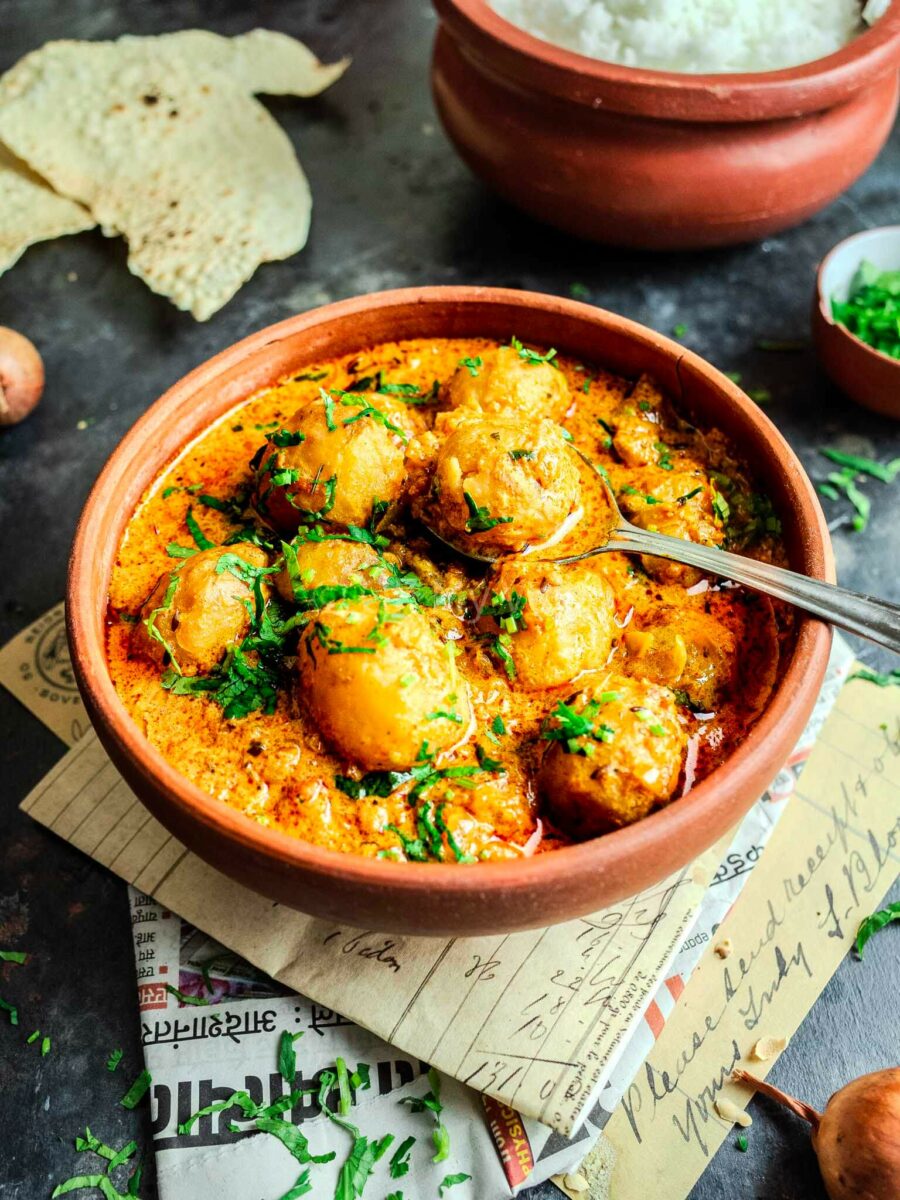
How to Make Dum Aloo
If you’re familiar with cooking Indian curries, whipping up this delicious Punjabi dum aloo will be a walk in the park.
Even if you don’t have any experience as a complete beginner, it’s surprisingly easy once you break it down into manageable steps. I recommend familiarizing yourself with the order of processes and then consulting the full recipe for detailed failsafe instructions.
- Parboil the potatoes in salted water, then peel them.
- Deep-fry the potatoes until golden brown outside.
- Fry the whole spices in oil until they smell aromatic.
- Sauté the onion, ginger-garlic paste, and tomato until softened.
- Add the ground spices, mix well, add water to adjust the consistency, and add the fried potatoes.
- Let the curry simmer until the potatoes are knife-soft.
- Add the yoghurt after whisking it well, then add the cream.
- Season the curry to taste with sea salt, garam masala, and finally, kasuri methi.
And you’re ready to serve! Isn’t it straightforward?
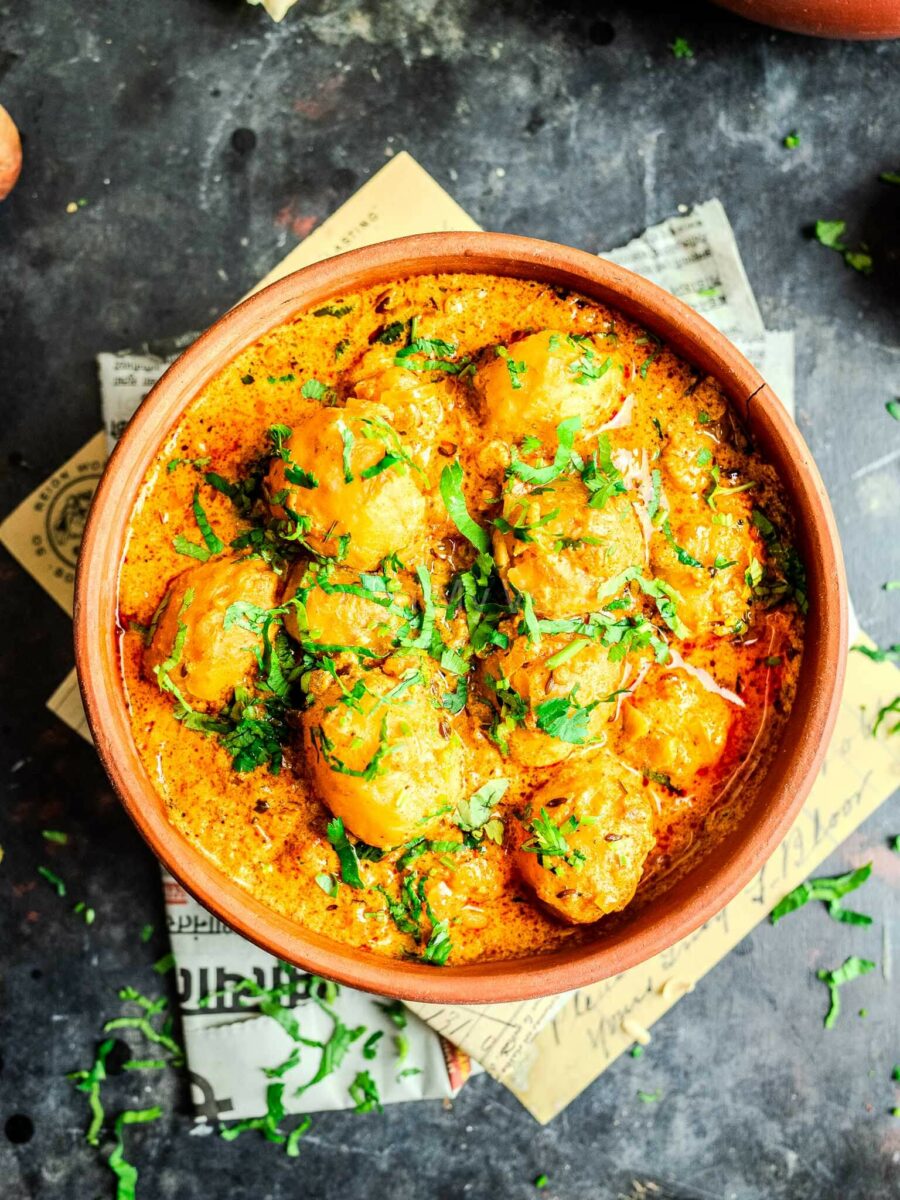
What Goes Well with Dum Aloo
Want to cook up a feast? You’ll need a few accompaniments for this restaurant-style dum aloo recipe! Let’s dive into some of the best options:
- Punjabi dum aloo with steamed rice is my top choice! It’s uncomplicated, and the thick, tangy gravy is ideal for mixing with fragrant, fluffy rice. I like using ambemohar, sona masoori, or basmati rice, but any aromatic variety is excellent.
- Coriander and garlic naan taste unbelievable with this easy dum aloo recipe. Mopping up the spicy curry sauce with a piece of buttery and pillowy garlic coriander naan is a game-changer!
- Roti/chapati or paratha is the best option if you want bread, but something lighter and more homely than naan.
- Classic accompaniments like crispy onion bhaji, moreish okra fries, kachumber (salad), and takeaway-style mint raita elevate the dum aloo.
- Vegetable side dishes such as bhindi masala and dal tadka are great if you want to serve an array of plates.
This Recipe Is:
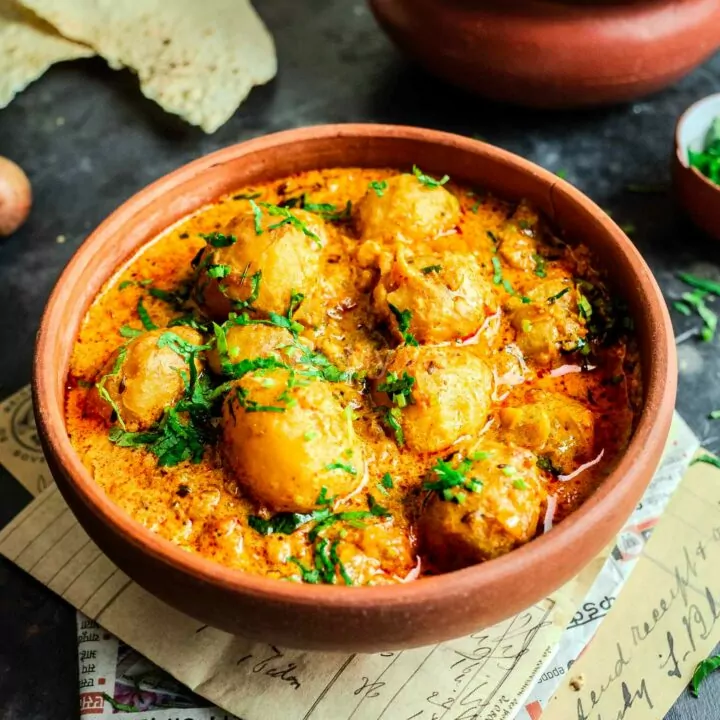
Dum Aloo
This easy vegetarian Punjabi dum aloo recipe has a tangy, sour, spicy, and creamy curry gravy coating tender potatoes.
Ingredients
- 1 ltr Neutral Oil, to deep fry
- 650g Baby potatoes
- 1.5 tbsp Mustard oil
- 1 tsp Cumin seeds
- 3 Green cardamon
- 1 Black cardamon
- 1 Cinnamon stick
- 3 Indian Bay leaves
- 2 Cloves
- 1 Red Onion, finely minced
- 2 tsp Ginger garlic paste
- 240g Tomato, pureed
- 1/4 tsp Turmeric powder
- 1 tsp Coriander powder
- 1/2 tsp Red Chili powder
- 2 tsp Kashmiri Chili powder
- 180g Yogurt
- 300ml Water
- 1 tbsp Double Cream
- 1 tsp Kasuri methi (dried fenugreek leaves)
- 1/8 tsp Garam Masala
- Sea salt, to taste
- Fresh Coriander, finely chopped, to serve
Instructions
- Begin by parboiling the potatoes in salted boiling water for just under 5 minutes. Drain, cool, and then peel the potatoes.
- Deep-fry the potatoes. Heat neutral oil in a large deep-fat fryer or kadai*. Use a food thermometer and add the potatoes once the oil reaches 190 C (375 degrees F). Fry until golden brown, then drain on kitchen paper and set aside.
- Fry the whole spices. Heat mustard oil in a large kadai over low-medium heat and immediately add the cumin seeds. Once they gently crackle add the green cardamom, black cardamom, cinnamon sticks, bay leaves, and cloves.
- Make the curry base. Add the onion and sauté until golden to develop depth of flavor. Add the ginger-garlic paste, stir until the raw smell fades, then add the tomato paste. Mix well.
- Add the ground spices, including turmeric powder, coriander powder, and both types of red chili powder. Mix well and let the base cook over low heat for at least 10 minutes, stirring consistently to avoid sticking. Add a dash of hot water if necessary.
- Make the gravy and add the potatoes. Add 300ml to adjust the consistency. Next, take the yogurt in a bowl and whisk it thoroughly. Add the yogurt to the curry gravy along with the fried potatoes, and stir well. Let it simmer until the potatoes have softened (test with a knife).
- Season the curry with kasuri methi (crush this between your palms before adding to bring out the aroma), garam masala, sea salt to taste, and a splash of double cream. Mix, turn off the heat, and serve with fresh coriander.
Notes
* Always exercise caution when cooking with large amounts of hot oil. If you prefer, you can air-fry the potatoes.
Recommended Products
As an Amazon Associate and member of other affiliate programs, I earn from qualifying purchases.
Nutrition Information:
Yield: 4 Serving Size: 1Amount Per Serving: Calories: 393Total Fat: 15gSaturated Fat: 3gTrans Fat: 0gUnsaturated Fat: 12gCholesterol: 7mgSodium: 422mgCarbohydrates: 58gFiber: 7gSugar: 8gProtein: 9g
Nutrition information isn’t always accurate.







